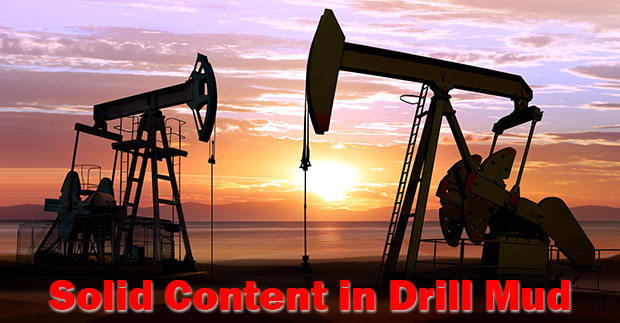Solid content is a fraction of the total solid in drilling mud, and it always increases while drilling ahead because of drilling solid (cuttings), mud chemical additives and weighting material. Solid content refers to soluble and insoluble solid content in the drilling fluid system.

Solid Content in Drill Mud
There are three types of solid contents as listed below;
– Soluble material such as salt
– Insoluble high gravity solid (HGS) such as weighting agents (barite, calcium carbonate, hematite, etc.)
– Insoluble low gravity solid (LGS) or drilled solid such as solids particles from cuttings
The drill solids are the worst solid content in the drilling fluid because it gradually deteriorates mud properties. Moreover, if its particle size is less than 5 microns, these drill solids cannot be removed by mechanical methods, and they will stay in the mud forever. Generally, the drill solids will take up 6-7 percent of the total mud volume. Since the drilled solid content is very important, it must be checked daily. For good drilling practices, the drilled solid should be tested twice a day by retorting. The upper limit of the drill solid faction should be 6-7 % by volume or approximately 55 – 60 lb/bbl.
Another critical value besides low gravity solid (LGS) and high gravity solid (HGS) is the average density of weighting materials in drilling fluid. The weighting materials such as Barite, Calcium Carbonate, Hematite, etc., have a specific gravity above 2.7. Table 1 demonstrates some important specific gravity of weighting materials.

Table 1 – Specific Gravity of Weighting Materials
However, the drilled solids usually have a specific gravity about 2.6. Hence, drill solids will reduce average solid density when mixed in the drilling fluid. Normally, the acceptable value of the average solid density is about 3.8 or higher. If this value is below 3.8, it indicates that there may be too much low gravity solid in the mud.
The operational impacts of solid content
The solid content has several operational impacts on drilling operation as listed below;
Equivalent Circulating Density (ECD)
ECD will be higher if the solid content increases. Excessive ECD will lead to formation fracture and a loss circulation issue.
Differential Sticking
The filter cake will be thick and sticky, if there are a lot of low gravity solids in the drilling mud. Due to this reason, the potential of getting deferentially stuck across permeable formations is increased.
Rate of penetration
High concentration of the solid content will reduce the overall rate of penetration. There are three solid contents added into the system. The first two contents are weighting material and chemicals which are needed to maintain good mud properties. The last one is the drill solid which can be controlled by mechanical methods. If the drill solid content is not controlled properly, drilling performance will decrease.
Surge/swab pressure
The excessive surge and swab pressures result from the high amount of solid contents in the fluid system.
References


